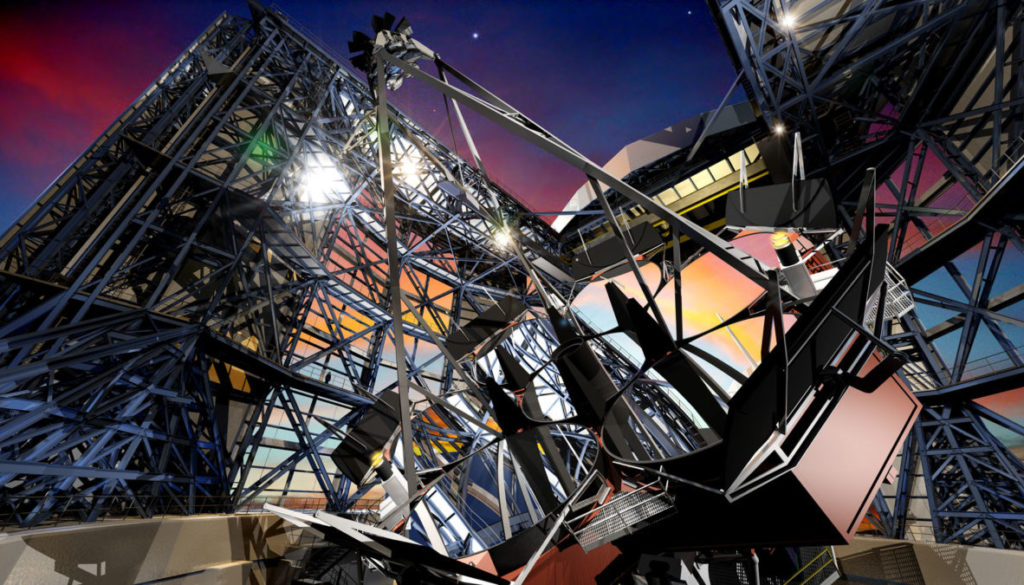Giant Magellan Telescope Breaks Ground in Chile
Leading scientists, senior officials and supporters from an international consortium of universities and research institutions including Texas A&M University are gathering on a remote mountaintop high in the Chilean Andes today (Wednesday, Nov. 11) to celebrate groundbreaking for the Giant Magellan Telescope.
The ceremony marks the commencement of onsite construction of the telescope and its support base, according to Giant Magellan Telescope Organization officials, who also note that the GMT is poised to become the world’s largest telescope when it begins early operations in 2021. It will produce images 10 times sharper than those delivered by the Hubble Space Telescope and will address key questions in cosmology, astrophysics and the study of planets outside our solar system.


“We are thrilled to be breaking ground on the Giant Magellan Telescope site at such an exciting time for astronomy,” said GMTO Board Chair Taft Armandroff, director of the McDonald Observatory at the University of Texas at Austin. “With its unprecedented size and resolving power, the Giant Magellan Telescope will allow current and future generations of astronomers to continue the journey of cosmic discovery.”
The GMT will be located at the Las Campanas Observatory in Chile’s Atacama Desert. Known for its clear, dark skies and outstanding astronomical image clarity, Las Campanas is one of the world’s premier locations for astronomy. Construction crews will soon be busy on the site building the roads, power, data and other infrastructure needed to support the observatory.


“A project like the GMT takes a long time from the initial concepts to final use as a scientific instrument,” said Texas A&M astronomer Darren L. DePoy, deputy director of the George P. and Cynthia Woods Mitchell Institute for Fundamental Physics and Astronomy and director of Texas A&M’s Munnerlyn Astronomical Instrumentation Laboratory, where first-light devices and measurement systems for the telescope are being built and assembled. “Milestones like this one are terrific opportunities to pause and reflect on the great progress of the telescope, the many problems that have been solved and the exciting science ahead. Although there is still a lot to do, the GMT is moving ahead and is in an excellent position to be the first of the next generation of enormous telescopes. We look forward to the completion of the telescope and to the wonderful science we will tell the world about in the next decade.”
Watch a brief animation of the GMT below and visualize its colossal size, state-of-the-art instrumentation and groundbreaking potential, courtesy of Todd Mason and Mason Media Inc. View the extended version on the Texas A&M Science YouTube channel.
Check out bonus coverage in Texas A&M’s campus newspaper, The Battalion, featuring quotes and commentary from Texas A&M physics graduate students Daniel Nagasawa and Ting Li.
The unique design of the telescope combines seven of the largest mirrors that can be manufactured, each 8.4 meters (27 feet) across, to create a single telescope effectively 25 meters (85 feet) in diameter. The giant mirrors are being developed at the University of Arizona’s Richard F. Caris Mirror Laboratory. Each mirror must be polished to an accuracy of 25 nanometers, or one-millionth of an inch.
One giant mirror has been polished to meet its exacting specifications, and three others are being processed, with production of the remaining four mirrors set to progress at the rate of one per year. The telescope, which will begin early operations with the initial four mirrors in 2021, is expected to reach full operational capacity within the next decade.
“An enormous amount of work has gone into the design phase of the project and development of the giant mirrors that are the heart of the telescope,” said Patrick McCarthy, GMTO interim president. “The highest technical risks have been retired, and we are looking forward to bringing the components of the telescope together on the mountaintop.”
The GMT will enable astronomers to characterize planets orbiting other stars, witness early formation of galaxies and stars, and gain insight into dark matter and dark energy. Its findings will also likely give rise to new questions and lead to new and unforeseen discoveries.
“The Giant Magellan Telescope will be the first of the new generation of very large optical telescopes,” said Nicholas B. Suntzeff, university distinguished professor of physics and astronomy and director of the Texas A&M astronomy program since 2006. “With construction beginning this week, we are on schedule to be on the sky well before the other two telescopes. The sudden leap from the Keck telescopes, which are 10-meter mirrors, to the new generation of telescopes of more than 25 meters increases the reach of the telescope into the universe by more than a factor of six. If there are rocky planets like the Earth with atmospheres that contain signs of life, we have a good chance of discovering life on other planets with this telescope.
“The birth of the universe as we know it — the stars, galaxies and the beginning of the formation of the elements on the periodic table — is just beyond the reach of present telescopes on the ground and space. The GMT, as the first giant telescope to get onto the sky, will map out the birth of these new galaxies and stars, along with the data from James Webb Space Telescope, set to be launched in 2018.”
The GMTO Board of Directors, which includes former Texas A&M Dean of Science H. Joseph Newton as vice chair, officially approved the project’s entry into the construction phase in early 2015 after the 11 international founders committed more than $500 million toward the project. Founders come from the U.S., Australia, Brazil and Korea, with Chile — where Suntzeff spent 20 years as the associate director for science at the U.S. National Optical Astronomy Observatory (NOAO)/Cerro Tololo Inter-American Observatory (CTIO) in La Serena prior to coming to Texas A&M — as the host country.
“With today’s groundbreaking, we take a crucial step forward in our mission to build the first in a new generation of extremely large telescopes,” said GMTO Board Member Charles Alcock, director of the Harvard/Smithsonian Center for Astrophysics. “The GMT will usher in a new era of discovery and help us to answer some of our most profound questions about the universe. We are pleased to celebrate this momentous milestone with our Chilean colleagues, our international partners and the astronomical community.”
Access the GMTO’s video news package, which includes interviews with GMTO partners and b-roll as well as images and video graphics of the Giant Magellan Telescope.
About the Giant Magellan Telescope
The Giant Magellan Telescope (GMT) is slated to be the first in a new class of extremely large telescopes, capable of producing images with 10 times the clarity of those captured by the Hubble Space Telescope. The GMT aims to discover Earth-like planets around nearby stars and the tiny distortions that black holes cause in the light from distant stars and galaxies. It will reveal the faintest objects ever seen in space, including extremely distant and ancient galaxies, the light from which has been traveling to Earth since shortly after the Big Bang 13.8 billion years ago. The telescope will be built at the Carnegie Institution for Science’s Las Campanas Observatory in the dry, clear air of Chile’s Atacama Desert, in a dome 22 stories high. GMT is expected to see first light in 2021 and be fully operational by 2024.
The telescope’s primary mirror combines seven 8.4-meter (27 feet) diameter circular segments to form an effective aperture 24.5 meters in diameter. Each mirror segment weighs 17 tons and takes one year to cast and cool, followed by more than three years of surface generation and meticulous polishing at the Richard F. Caris Mirror Lab within the Steward Observatory at the University of Arizona in Tucson, Ariz. Funding for the project comes from the partner institutions, governments and private donors.
About the Giant Magellan Telescope Organization
The Giant Magellan Telescope Organization (GMTO) manages the GMT project on behalf of its international partners: Astronomy Australia Ltd., The Australian National University, Carnegie Institution for Science, Fundação de Amparo à Pesquisa do Estado de São Paulo, Harvard University, Korea Astronomy and Space Science Institute, Smithsonian Institution, Texas A&M University, The University of Arizona, The University of Chicago, and The University of Texas at Austin.
Connect with the Giant Magellan Telescope Organization on social media: gplus.to/gmtelescope, twitter.com/GMTelescope, facebook.com/GMTelescope, instagram.com/gmtelescope/ and visit http://www.gmto.org.
-aTm-
MEDIA CONTACTS
Jacqueline Efron, 650-801-0942 or jacqueline.efron@zenogroup.com
Davin Malasarn, 626-204-0529 or dmalasarn@gmto.org
Shana Hutchins, 979-862-1237 or shutchins@science.tamu.edu
BUSINESS CONTACTS
Patrick McCarthy, 626-204-0501
Taft Armandroff, 512-471-3300
Nicholas Suntzeff, 979-229-9597 or nsuntzeff@tamu.edu
The post Giant Magellan Telescope Breaks Ground in Chile appeared first on College of Science.
